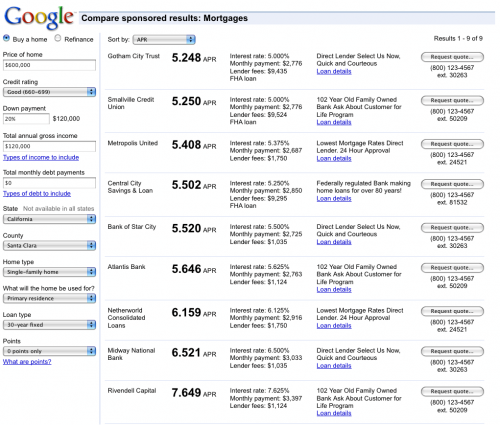Google Launches Comparison Ads, Starting With Mortgages
Google’s now officially announced “Comparison Ads,” starting with a way for mortgage advertisers to have their products compared against each other but which may expand to other products in the future. “If you’re looking for a mortgage, you really care about a specific offer. You want to know the APR and based on your specific […]
Google’s now officially announced “Comparison Ads,” starting with a way for mortgage advertisers to have their products compared against each other but which may expand to other products in the future.
“If you’re looking for a mortgage, you really care about a specific offer. You want to know the APR and based on your specific circumstances, which is something that AdWords doesn’t provide today,” said Nick Fox, director of business product management for AdWords at Google.
In the new system, those search for “mortgage” or “refinance” or related terms may see an special ad from Google itself inviting them to view offers, like this:
Note that while the product was just announced, not everyone may see these ads yet. Google says they’ll be fully deployed over the next week. They’ll be visible in specific states where the ads have matching content (more about that below).
Clicking on that ad takes them to a page where they can view a variety of related mortgage offers from various lenders, like this:
You can also go directly to the comparison area here. The page allows you to filter rate offers based on size of loan, your credit rating, your gross income, state, county and other options.
The service is currently only offered in the US and even there, not for every state. For example, you won’t find offers for Alaska (and consequently, those in Alaska won’t see comparison ads triggered on mortgage-related searches).
Fox told me there are a variety of reasons preventing universal coverage at the moment, such as some regulatory issues plus that they simply don’t have enough advertisers on board in some places to provide a robust product. Google’s also experimented with a similar product in the UK in 2008. That no longer runs, but what Google learned from the test there was applied to today’s US rollout, the company told me.
Ads are sold on a cost-per-lead basis. When someone clicks to receive a quote, the advertiser is forwarded the information and billed. The advertiser also receives no personal information about the person. In fact, they don’t even get the person’s real phone number. Google provides a temporary bridging number that connects the advertiser to the customer. After that, it’s up to the customer to provide their own “real” number if they want follow-up, Fox said.
Having gone through a remortgage recently, I raised the issue that often rates advertised don’t actually match what you get in the end. Nick Fox said Google’s done work to help eliminate this.
“These are not teaser rates. These are real rates based on what’s used in the industry,” he said, saying that the system pulls back from current data.
The system also uses IP detection to automatically guess at your area. When I tried it, it correctly preset the filters to my state and county.
While mortgages are being offered to start, Google expects other products eventually will be added.
“We don’t have anything to announce in terms of the future areas this will expand in. We’ll learn from the mortgages experiment, how well it is working, where it is working and based on that, we’ll have a better sense of other places to expand the product to,” Fox said.
Opinions expressed in this article are those of the guest author and not necessarily Search Engine Land. Staff authors are listed here.
Related stories
New on Search Engine Land

